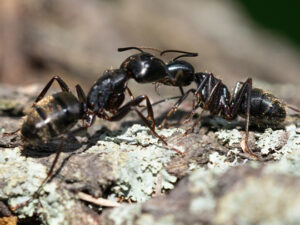
Tiny Thief Ants Establish Large Indoor Nests Behind Kitchen Cupboards, Allowing Them Easy Access To Stored Foods
Ant species that establish multiple nests and live in colonies that contain several queens are particularly difficult to eradicate from infested homes. Queen ants are generally the only reproductive ants found in a colony, so killing worker ants that residents often see crawling about within their home will not remedy an infestation in the slightest. In order to effectively eliminate an ant infestation, the queen ant must be located and destroyed, but this is typically a difficult undertaking when an ant colony contains multiple queens. Also, while not all ant pests are capable of establishing indoor nests, those that are capable establish nests within obscure, and often, inaccessible locations within homes.
Ant nests are frequently found in wall voids, tight attic spaces, beneath floorboards and behind baseboards. Pinpointing the indoor location of one ant nest is difficult enough, but locating several is a tall order, even for the most seasoned pest control professionals. Many ant species establish a “parent” nest located outdoors, as well as multiple “satellite nests” within houses. One such ant species, the thief ant, can be found throughout the state of New York, and as pests they may establish one nest outdoors, several nests indoors, or both. Thief ant colonies contain multiple queens, and colonies are small enough to fit behind baseboards, which is where they are frequently discovered.
Thief ants are yellow to light brown in color, and are extremely small ants, as workers are only 1/32 of an inch in length. Thief ant workers may enter homes from outside nests located beneath rocks, leaf litter or wood, or they may establish one or more indoor nests. Thief ant workers enter homes in order to gather discarded food scraps, but they are well known for eating their way inside packaged food items, which is why they are often found infesting kitchen cupboards and pantries. In fact, thief ants often establish one or more nests in wall voids located behind cupboards and pantries in order to secure quick and easy access to a food source. Like many ant species, thief ants enjoy sweet foods, but they prefer to feed on high protein and greasy food sources, which includes potato chips, dried meat, cereal and most food items found within a typical pantry. Despite living in small colonies, these ants rapidly disperse throughout homes due to their ability to crawl along electrical wires and pipes within wall voids.
Have you ever found ant pests within your cupboards or pantry?










